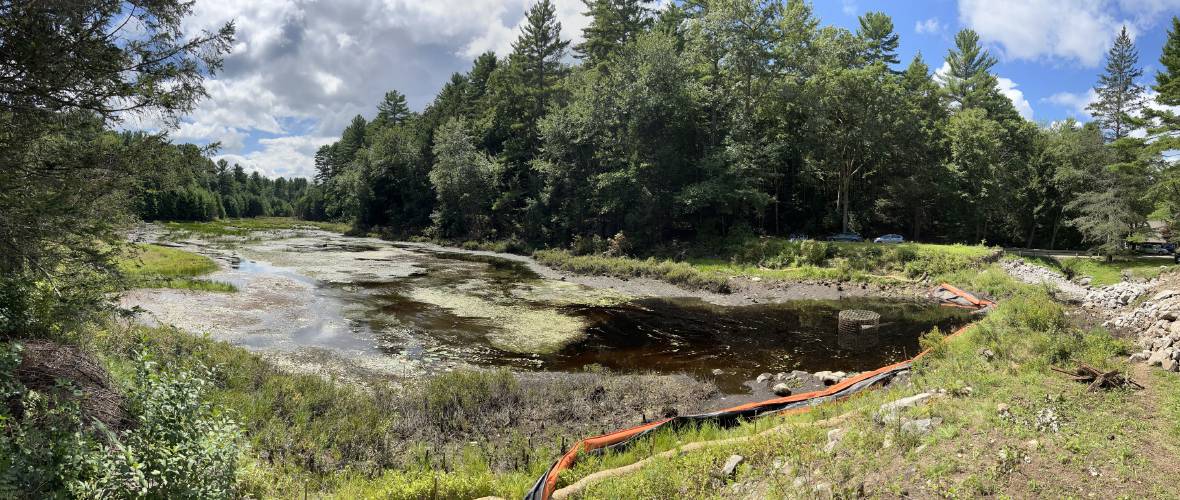Shutesbury’s Dudleyville Forest poised for preservation

The Dudleyville Forest in Shutesbury is set to be preserved early next year. The 200 acres includes a mix of white pine and mixed hardwoods. FILE PHOTO
| Published: 12-16-2024 12:26 PM |
SHUTESBURY — Kestrel Land Trust is permanently protecting a forest featuring more than 200 acres of white pine and mixed hardwoods on Montague Road, where a centuries-old dam was removed over the summer.
A $327,000 grant from the Executive Office of Energy and Environmental Affairs’ Land Acquisition for Forest Reserves Grant Program is part of more than $5 million going to 10 land trusts and communities to protect forests that will be managed as reserves across Massachusetts.
The grant will cover half of the total project costs for preserving the so-called “wildlands,” with Kestrel Land Trust raising money from private foundations and the public to get the remaining money needed in early 2025. The idea of the project is that the relatively young forest will develop into a mature forest without being disturbed by commercial forest harvesting.
“Kestrel is very appreciative of this grant, and is excited to now be able to work earnestly with the Brown family of Shutesbury to protect their forest as a wildland,” Lee Halasz, conservation manager for Kestrel Land Trust, said in a statement. “The Brown family has been interested in protecting their land for many years, and with the recent removal of a dam wall on the parcel, the family was more able to focus on land protection.”
The Shutesbury land, known as the Dudleyville Forest, has been designated a Critical Natural Landscape and mapped for regional connectivity. The project is expected to be completed mid-2025.
A report published by Harvard Forest and Northeast Wilderness Trust, “Wildlands in New England: Past, Present and Future,” states that while Massachusetts has protected nearly a third of the state’s forests, only 2% is considered wildland: “Wildlands, by design, allow natural processes to unfold with no active management or intervention. These forever-wild places support global efforts to mitigate the impact of climate change while also securing the future of New England for all life — human and wild — to inhabit and enjoy.”
“These 200 acres support a diverse forest at 1,000 feet elevation, including 20 acres of vigorously regenerating white pine,” Halasz said. “There are several shrubby wetlands embedded within the forest and what promises to be a dynamic wetland environment upstream of the former dam.”
The land is recognized as important habitat in BioMap, the state’s strategic plan for conserving biodiversity, as well as in The Nature Conservancy’s Resilient Land Mapping Tool, which identifies lands that will continue to provide important wildlife habitat into the future.
Article continues after...
Yesterday's Most Read Articles
 Request for proposals being prepped for Greenfield’s First National Bank
Request for proposals being prepped for Greenfield’s First National Bank
 Orange department heads voice frustration over potential 15% budget cuts
Orange department heads voice frustration over potential 15% budget cuts
 Baseball: Greenfield's Conner Bergeron allows just one hit as Wave take down Turners Falls, 11-1, in five innings
Baseball: Greenfield's Conner Bergeron allows just one hit as Wave take down Turners Falls, 11-1, in five innings
 With traveling Busload of Books, husband and wife look to inspire love of reading
With traveling Busload of Books, husband and wife look to inspire love of reading
 No Montague Soapbox Derby this year
No Montague Soapbox Derby this year
 One year on, Franklin County chapter of 100+ Women Who Care gaining momentum
One year on, Franklin County chapter of 100+ Women Who Care gaining momentum
This forest is situated between several large blocks of conservation land, including the 3,486-acre Paul C. Jones Working Forest, protected with a conservation restriction in 2011 by the Massachusetts Department of Fish and Game with Kestrel’s assistance, and the town’s Lake Wyola Conservation Area, which is near Kestrel’s Bright Water Bog Nature Retreat that protects Ames Pond.
Shutesbury’s Open Space and Recreation Plan also states “one of the greatest ecological strengths of Shutesbury’s landscape is the prevalence of large, contiguous forest blocks.”
“Forests are our best natural carbon sinks,” said Energy and Environmental Affairs Secretary Rebecca Tepper when the grants were announced. “As trees age, they absorb and store more carbon dioxide — crucial in helping us fight climate change. By supporting community and land trust efforts to limit land conversion and increase permanent land conservation, we are preserving forests for generations to come.”
The grant program, a result of the Forests as Climate Solutions initiative, aims to designate 10% of Massachusetts forests as reserves, where active management is limited and natural processes play out. By increasing the pace of permanent forest protection, Massachusetts is aiming to achieve the goals outlined in the Clean Energy and Climate Plan, conserving 40% of the state’s forests by 2050.
Scott Merzbach can be reached at smerzbach@gazettenet.com.






 PHOTOS: Making progress at Bridge of Flowers
PHOTOS: Making progress at Bridge of Flowers ‘A real joy to work with’: Orange letter carrier retires after 31 years
‘A real joy to work with’: Orange letter carrier retires after 31 years PHOTO: Sticking to it
PHOTO: Sticking to it
